Content
Published:
This is an archived release.
Re-calculation of wastewater statistics for 2002-2013
The re-calculation is due to changes in methodology and insufficient reporting in the early 2000s. The statistics have been updated dating back to 2002. Discharges of phosphorus (TOT-P) for the period 2002-2013 and the number of wastewater facilities in 2002-2006 in particular have been affected.
| 2013 | Per cent | ||
|---|---|---|---|
| 2012 - 2013 | 2009 - 2013 | ||
| Number of wastewater facilities, 50 pe or larger | 2 677 | -1.2 | -4.7 |
| Capacity of wastewater facilities 50 pe or larger (1 000 pe) | 6 832.4 | 0.5 | 3.8 |
| Discharge phosphorus from wastewater facility 50 pe or larger (tonnes TOT-P) | 918.3 | 2.5 | 4.0 |
| Discharge organic material from wastewater facility 50 pe or larger (tonnes BOD5) | 44 267 | 16.1 | . |
| Disposal of sewage sludge to soil improvement (tonnes dry weight) | 112 493 | 9.9 | 23.3 |
| Used in agriculture | 82 632 | 17.9 | 26.0 |
| Used in parks or green spaces | 11 706 | -15.6 | 54.8 |
| Delivered to soil producers | 18 155 | -1.5 | 0.3 |
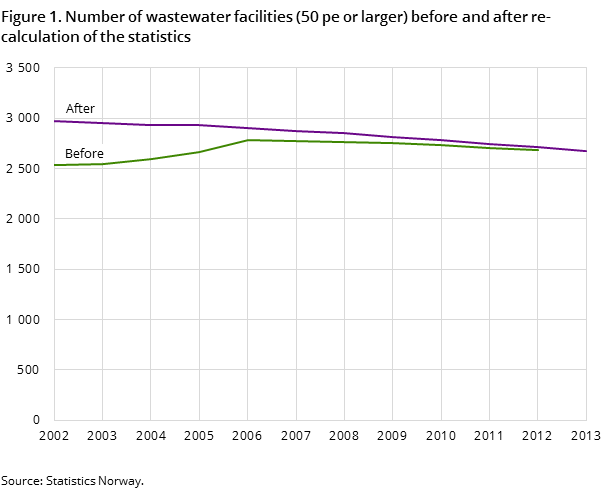
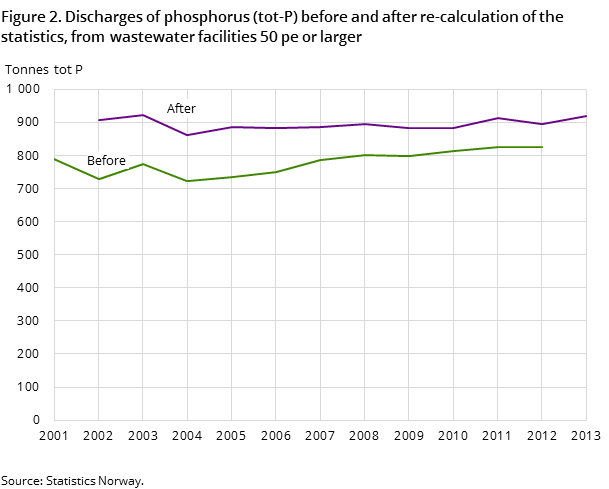
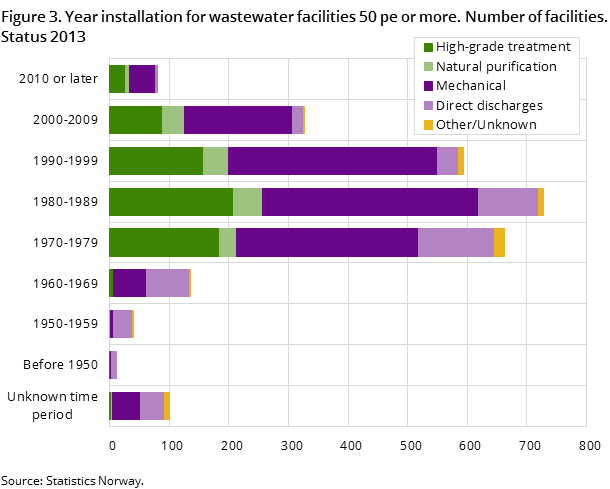
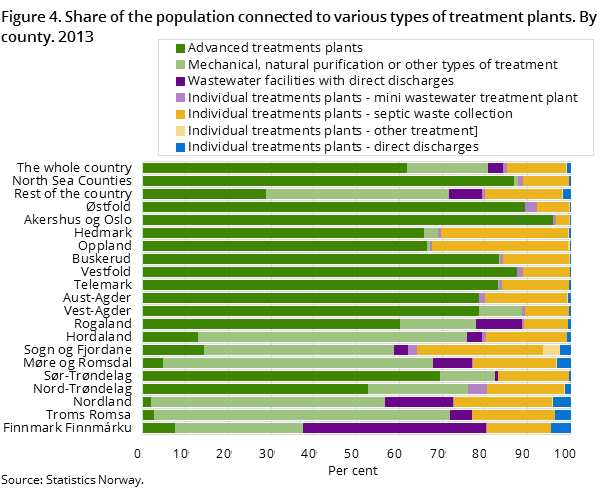
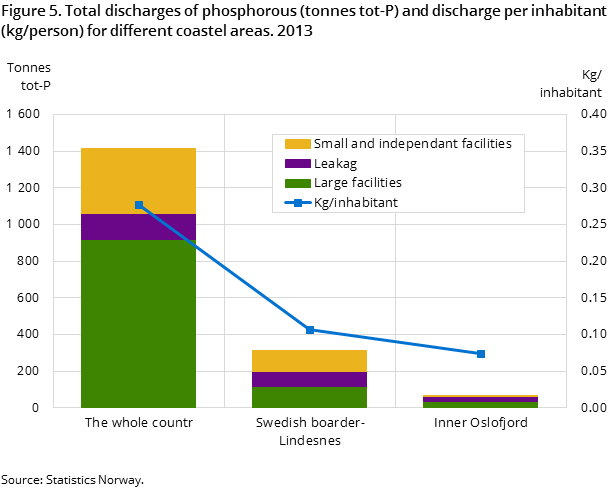
For example, the number of wastewater facilities (50 person equivalents (pe) or larger) in 2002 has increased from 2 500 before re-calculation to around 3 000 after the re-calculation, and the updated statistics now show a clear downward trend in the number of wastewater facilities throughout the whole period of 2002-2013.
As for discharges of phosphorous, the calculation method has also been changed and this alone has led to an increase in discharges. The trend now is a relatively stable discharge of around 900 tonnes of phosphorous for 2002-13, while before re-calculation the level was between 7-800 tonnes and there was a slight increasing trend throughout the same time period. See separate figures on the effect of re-calculation.
Nitrogen (TOT-N), on the other hand, shows a steady increase in discharges compared to the more “stable phosphorous”, and according to updated statistics has increased from 11 900 tonnes in 2002 to 14 200 tonnes in 2013. This can partly be explained by today’s choice of treatment technology and the more predominant focus on phosphorous removal compared to nitrogen in Norway.
The effect of re-calculations on people connected and the capacity of wastewater facilities is minor, but also here, the numbers have been slightly adjusted.
Updated statistics and figures have all been released in the new report Municipal wastewater: Expenditures, investments, discharges, treatment and disposal of sewage sludge 2013 – Wastewater fees 2014 (in Norwegian only, with an English abstract).
920 tonnes of phosphorous
For 2013, the discharges of phosphorous (TOT-P) from the municipal wastewater sector have been estimated at 920 tonnes. This constitutes a 2 per cent increase compared to the year before. Per inhabitant connected, this discharge corresponds to 0.21 kg phosphorous per year.
The phosphorous treatment efficiency of the wastewater sector as a whole has been estimated at 68 per cent of the incoming amount.
When estimations of leakage from the pipeline system (140 tonnes) and discharges from small independent wastewater facilities (350 tonnes) are also added, the total figure is around 1 400 tonnes for the whole sector.
Three out of five connected to high-grade treatment
In 2013, 62 per cent of Norway’s population was connected to high-grade treatment plants – biological and/or chemical treatment. This is around the same level as in 2012. Unlike mechanical treatment, chemical/biological treatment can remove many of the pollutants from the wastewater before being discharged into rivers and water systems. This applies in particular to phosphorous and organic material, but also other types of pollutants.
Furthermore, the statistics show that 19 per cent of the population was connected to mechanical or other types of treatment, 3 per cent had direct discharges and the remaining 16 per cent of the population were connected to small wastewater facilities (less than 50 pe).
Infrastructure from the 1970s and 80s
Ninety per cent of the country’s 2 677 wastewater facilities were started up in the 1970s or later. Wastewater facilities in Norway have therefore changed considerably since that time. Half of the wastewater facilities in Norway were started up in the 1970s and 80s alone.
Furthermore, only a few facilities treat really large quantities of wastewater in Norway, with 4 per cent of the wastewater facilities being 10 000 pe or larger and accounting for almost 70 per cent of the total capacity of the wastewater sector of 6.8 million pe. In comparison, facilities less than 2 000 pe constitute as much as 85 per cent of the facilities, but only account for 12 per cent of the total capacity.
Slight increase in costs of wastewater services
In 2013, the total cost for all municipalities was NOK 6.28 billion. This constitutes an increase of 6.6 per cent compared to 2012. The costs related to the wastewater sector are made up of capital costs and operating costs, and the increase mentioned is due to an increase in both operating and capital costs. The figures for the entire country are calculated based on the data reported in KOSTRA.
Wastewater fees are determined by the municipalities in accordance with the full cost principle. Local conditions such as patterns of built-up areas, topography, bedrocks in the ground, the need for pumping stations and treatment requirements are all factors behind the variation in fees.
A total of 59 per cent of the population live in municipalities with a contribution margin ratio of more than 100 per cent, which means that the incomes from fees are higher than the fee calculation basis. At the same time, a total of 79 per cent of the municipalities have a full cost ratio between 91 and 110 per cent, and these municipalities are home to 81 per cent of the population. A major part of the population lives in municipalities where the costs for wastewater services are covered by fees. The municipality may then use the surplus to fund provisions or cover earlier deficits.
The information box below is added 9 January.
Reason for re-calculationOpen and readClose
The statistics is based on a full count reporting. But due to lacking data on key parameters and reporting, especially in the years 2002-06, the time series has been adjusted backwards, partly also forward in time. An example of adjustment is if a facility were subject to reporting for the first time in 2005, but it also came clear that it was established as early as in 2002. Then the re-calculation takes this into account and adds the facility also for the years 2002, 2003 and 2004. Thus the whole time series of data are applied in rebuilding the population and the result is a more correct statistics.
Contact
-
Gisle Berge
E-mail: gisle.berge@ssb.no
tel.: (+47) 48 12 19 97
